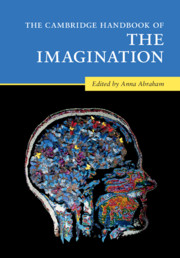Book contents
- The Cambridge Handbook of the Imagination
- The Cambridge Handbook of the Imagination
- Copyright page
- Dedication
- Contents
- Figures
- Contributors
- Acknowledgments
- 1 Surveying the Imagination Landscape
- Part I Theoretical Perspectives on the Imagination
- Part II Imagery-Based Forms of the Imagination
- Part III Intentionality-Based Forms of the Imagination
- Part IV Novel Combinatorial Forms of the Imagination
- Part V Phenomenology-Based Forms of the Imagination
- Part VI Altered States of the Imagination
- 40 Dreaming: Beyond Imagination and Perception
- 41 Dreaming is Imagination Roaming Freely, Based On Embodied Simulation, and Subserved by an Unconstrained Default Network
- 42 Aphantasia
- 43 Hypnosis and Imagination
- 44 Hallucinations and Imagination
- 45 The Psychiatry of Imagination
- 46 Meditation and Imagination
- 47 Flow in Performance and Creative Cognition – An Optimal State of Task-Based Adaptation
- 48 The Force of the Imagination
- Name Index
- Subject Index
- References
44 - Hallucinations and Imagination
from Part VI - Altered States of the Imagination
Published online by Cambridge University Press: 26 May 2020
- The Cambridge Handbook of the Imagination
- The Cambridge Handbook of the Imagination
- Copyright page
- Dedication
- Contents
- Figures
- Contributors
- Acknowledgments
- 1 Surveying the Imagination Landscape
- Part I Theoretical Perspectives on the Imagination
- Part II Imagery-Based Forms of the Imagination
- Part III Intentionality-Based Forms of the Imagination
- Part IV Novel Combinatorial Forms of the Imagination
- Part V Phenomenology-Based Forms of the Imagination
- Part VI Altered States of the Imagination
- 40 Dreaming: Beyond Imagination and Perception
- 41 Dreaming is Imagination Roaming Freely, Based On Embodied Simulation, and Subserved by an Unconstrained Default Network
- 42 Aphantasia
- 43 Hypnosis and Imagination
- 44 Hallucinations and Imagination
- 45 The Psychiatry of Imagination
- 46 Meditation and Imagination
- 47 Flow in Performance and Creative Cognition – An Optimal State of Task-Based Adaptation
- 48 The Force of the Imagination
- Name Index
- Subject Index
- References
Summary
There is a strong overlap between imagined and hallucinatory phenomena in the sense that both are internal representations of external things that are not present at the time. Relationships between hallucinations and wider aspects of imagination are complex and individual, with a lack of systematic evidence. There appears to be a close relationship between the brain areas responsible for veridical, imagined, and hallucinatory perception, though more data is needed. However, how activity varies within and outside these areas in order to create different types of imagination is not at all clear. Drug effects provide one avenue for systematically exploring links between hallucinations and imagination. Drugs that cause hallucinations also tend to affect wider imagination and creativity, though results are variable and are open to alternative explanations. Nevertheless, these effects suggest that wider, non-perceptual, brain systems are involved in the generation of imaginative responses to hallucinations. Future investigations need to define imagination more closely, have tighter designs, and combine approaches.
Information
- Type
- Chapter
- Information
- The Cambridge Handbook of the Imagination , pp. 728 - 759Publisher: Cambridge University PressPrint publication year: 2020
References
Accessibility standard: Unknown
Why this information is here
This section outlines the accessibility features of this content - including support for screen readers, full keyboard navigation and high-contrast display options. This may not be relevant for you.Accessibility Information
- 1
- Cited by
